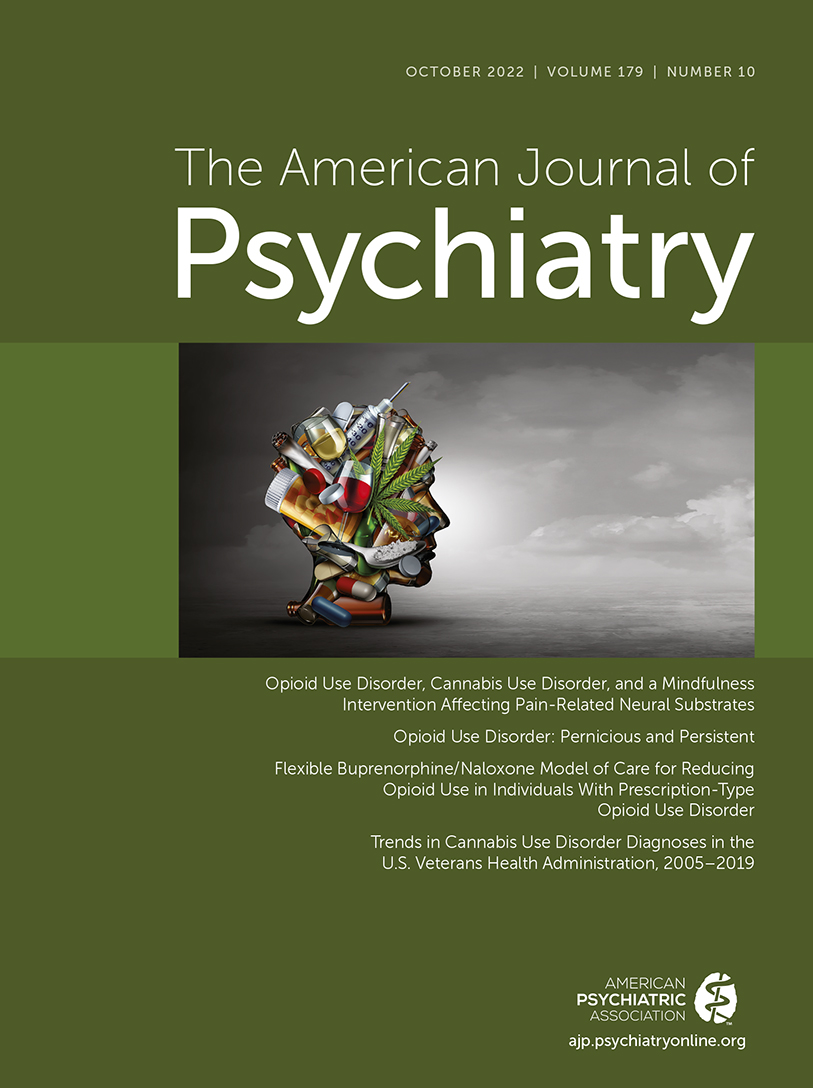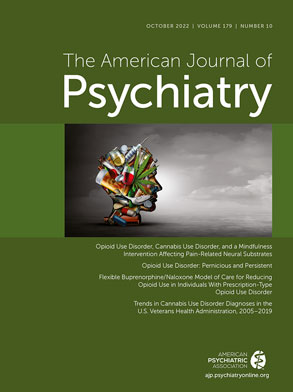Over the past several decades, rising rates of opioid overdose mortality in North America have underscored the importance of finding effective and safe treatment strategies to address this crisis. Medication for opioid use disorder (MOUD), including methadone, buprenorphine, and naltrexone, is effective in reducing opioid-related mortality and overdose (
1–
3). Unfortunately, numerous barriers prevent persons with opioid use disorder (OUD) from engaging in MOUD treatment, including inflexible dosing regulations necessitating patient travel and frequent clinical visits (
4). Low-barrier, flexible MOUD treatment models offer the potential to reduce barriers to accessing MOUD. The necessity of developing and examining innovative and flexible models of MOUD treatment has been amplified by the COVID-19 pandemic. To reduce the transmission of COVID-19, some regulations governing the induction, prescription, and dosing of MOUD in the United States, Canada, India, and European Union countries were revised (
5,
6). In addition to lowering barriers to MOUD initiation and increasing telemedicine treatment models, emergency regulations expanded take-home dosing of buprenorphine and methadone treatment (
5,
6). Despite the relaxation of these regulations to support access to MOUD and reduce harms, opioid-related overdose deaths in the United States and Canada have increased significantly since the start of the pandemic in March 2020 (
7). The consequences of the intersecting COVID-19 and opioid overdose crises underscore the urgent need for improved MOUD accessibility and the identification of treatment models supporting patient engagement and retention (
8). In this context, high-quality research investigating the effectiveness and safety of flexible, take-home dosing of MOUD is critical to inform public health responses and the development of treatment guidelines.
In this issue of the
Journal, Jutras-Aswad et al. (
9) present findings from the OPTIMA study, an open-label, noninferiority, two-arm parallel randomized controlled trial that compared the effectiveness of flexible, take-home dosing with buprenorphine/naloxone versus supervised methadone for people with prescription-type OUD (
10). Prescription-type OUD is highly prevalent, although little research has examined treatment models specific to this type of OUD (
11). Another strength of this study was its focus on flexible, take-home dosing of buprenorphine/naloxone. Previous research trials comparing buprenorphine/naloxone and methadone have predominantly included supervised dosing of MOUD (
12,
13). This pragmatic trial therefore assessed flexible, take-home dosing of buprenorphine/naloxone, a model of care routinely implemented in the United States (
14,
15), but less commonly implemented in Canada (
10).
In this multicenter trial, conducted at seven Canadian hospitals and community-based clinics, the authors recruited 272 treatment-seeking adults meeting DSM-5 criteria for OUD. Notably, the authors included only individuals who had prescription-type OUD and had primarily used an opioid pain reliever (including fentanyl) in the past 30 days. Individuals who primarily used heroin were excluded. Participants were randomized to receive either buprenorphine/naloxone or methadone. Clinically stable patients assigned to the buprenorphine/naloxone group were able to obtain take-home medication 2 weeks after induction. Clinically stable methadone patients were able to obtain take-home doses after 2 or 3 months of supervised dosing. While the proportion of opioid-free urine drug screens during the 24-week treatment period was the primary outcome, the authors also examined secondary outcomes, including retention in treatment and rates of adverse events.
After 24 weeks of study treatment, buprenorphine/naloxone was found to be noninferior to methadone in reducing opioid use, based on urine drug screen results. During the initial 12 weeks of study treatment, participants assigned to buprenorphine/naloxone had significantly lower rates of opioid-positive urine drug screens, although this difference between the buprenorphine/naloxone and methadone groups decreased during the final 12 weeks of treatment. In this sample of people with prescription OUD, take-home dosing of buprenorphine/naloxone was therefore as effective as methadone in reducing opioid use. As discussed by the authors, the lower rates of opioid-positive drug screens during the first 12 weeks of treatment for participants receiving buprenorphine/naloxone represents an advantage of this treatment model, since overdose and mortality rates are often highest for patients initiating and discontinuing MOUD treatment (
16).
Although the majority of participants in the methadone group continued supervised dosing, approximately one-third of methadone participants also engaged in take-home dosing. In the United States, methadone is only prescribed and dispensed in highly regulated opioid treatment programs (
17). Canadian provinces and territories determine methadone regulations independently (
18), often allowing for the prescription of methadone in office-based settings and the supervised dispensation of methadone in office-based or accredited community pharmacy settings (
19). Notably, rates of adverse events were comparable between the buprenorphine/naloxone and methadone groups, including rates of overdose. Retention rates to assigned treatment medication were higher for patients assigned to methadone. This closely parallels results of several meta-analyses demonstrating that MOUD treatment with methadone may be associated with higher assigned treatment retention rates compared with flexible dosing of buprenorphine (
20–
22). Although only a third of participants initiated take-home methadone dosing, investigating outcomes among this subgroup of patients may provide relevant and important information on the safety and effectiveness of take-home methadone dosing. A recent scoping review examined evidence for providing methadone in office-based settings with more flexible dosing regimens (
17). Although the review found few studies examining office-based methadone treatment, preliminary evidence suggested that retention rates and treatment satisfaction were similar between stable patients attending office-based methadone treatment and those attending traditional opioid treatment programs. Paralleling results of this scoping review, the findings from the OPTIMA study provide additional support for revising regulations for methadone in the United States to facilitate access for persons with OUD.
With the prevalence of fentanyl-laced heroin in the United States and other countries, examining the effectiveness of flexible, take-home dosing regimens for patients whose primary opioid is heroin or heroin-laced fentanyl is also critical. Approximately two-thirds of OPTIMA study participants reported lifetime heroin use. Heroin use may be associated with reduced retention in MOUD (
23), so exploring the effectiveness of take-home buprenorphine in this subgroup of people who use opioids is warranted. Interestingly, a secondary analysis of OPTIMA data compared opioid use and treatment retention outcomes among participants with and without fentanyl exposure at baseline (
24). Participants with positive urine drug screens for fentanyl at baseline were significantly more likely to report lifetime heroin use, have a positive urine drug test for stimulants, and have prior experience with MOUD. Additionally, these participants faced more challenges with social determinants of health, including reporting lower rates of housing and employment. The authors found no interaction between MOUD type and baseline fentanyl exposure after adjusting for participant demographic, substance use, and employment characteristics. Considering how patient characteristics and social determinants of health may influence treatment outcomes of flexible MOUD treatment models is important, as demonstrated by another recent study, by Nunes et al. (
25), comparing patient response to sublingual buprenorphine/naloxone versus extended-release injectable naltrexone. In that study, preferences for medication, housing status, and involvement in the carceral system similarly influenced rates of opioid use and medication initiation to naltrexone and buprenorphine/naloxone. Research exploring how patient characteristics, preferences, and social determinants of health may impact outcomes of flexible take-home dosing regimens would provide useful information for guiding patient care and potentially reducing health disparities.
Results of the pragmatic, noninferiority, randomized controlled OPTIMA study provide rigorous evidence that flexible, take-home buprenorphine/naloxone models can be as effective and safe as supervised dosing of methadone for people with prescription OUD. The study findings support the expansion of take-home dosing models of buprenorphine/naloxone while highlighting the importance of ensuring and enhancing access to methadone treatment. In the context of interconnecting global health crises, increasing access to flexible models of MOUD is critical to reduce opioid-related mortality.

